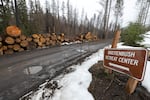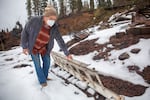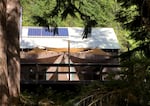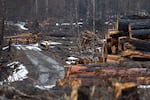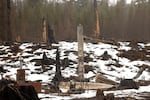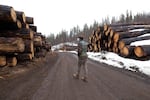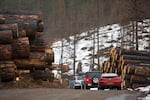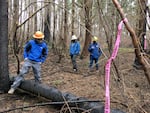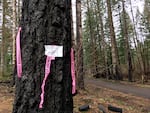
The charred remains of the Emersons' backyard destroyed in the Santiam Fire near Gates, Ore., Sept. 9, 2020.
Bradley W. Parks / OPB
Oregon lawmakers are considering two bills that aim to prevent the kind of catastrophic wildfires that tore through the state last year.
Senate Bill 287 and Senate Bill 248 would require mapping wildfire risk across the state and working to reduce it with more funding for wildfire response and a variety of policy changes.
The bills require new building codes for construction in fire-prone areas and a statewide standard for clearing “defensible space” around homes so they’re less likely to catch fire.
They call for the Oregon Department of Forestry to develop a prioritized plan for selective logging and controlled burning to reduce wildfire fuel loads, and they direct other state agencies to reduce health risks from wildfire smoke by monitoring air quality, creating “clean air shelters” and offering grants for smoke filtration systems in buildings.
The bills would also establish a baseline for wildfire protection services statewide and require electric utilities to create wildfire protection plans.
Altogether, the proposals represent the next generation of a wildfire response plan Oregon Gov. Kate Brown has been developing over the past two years.
Last year, Senate Bill 1536 outlined similar policy shifts, but it was one of many bills left to die at the end of the session after Republicans walked out to stop the passage of controversial climate change legislation.
The Governor’s Council on Wildfire Response concluded in a 2019 report that the best plan for reducing wildfire risk would cost about $4 billion and require “treating” more than 5 million acres of land over the next 20 years through selective logging and prescribed burning.
That was before wildfires tore across the state of Oregon last year, burning more than 1 million acres and destroying thousands of homes.
Sen. Jeff Golden, D-Ashland, who chairs the Senate Committee on Natural Resources and Wildfire Recovery, said the two bills will likely be consolidated into one bill with amendments that will be “the most important and urgent bill” for his committee to address this session.
“We have an enormous public policy challenge,” he said. “A bill like this and a change like this in the state’s approach to wildfire requires a lot of the various stakeholders. Normally, you’d have to take a long time to do that. We don’t have a long time.”
Golden said Oregonians expect lawmakers to move forward quickly to reduce the likelihood of another wildfire season like 2020.
At the committee’s public hearing on the bills Monday, people disagreed about whether Oregon should set one statewide standard for defensible space around homes or whether local governments should make that call.
Dave Hunnicutt with the Oregon Property Owners Association said he’s concerned about the state having control of defensible space rules without taking local input into account.
But Jackson County Fire Chief Bob Horton said failing to set a statewide standard for defensible space would be “irresponsible” and set up a “free rider problem,” in which counties that fail to set their own minimum standard could lean on state resources to fight the resulting fires.
While some advocates called for priority spending on tree thinning and fire suppression, others argued the new policy should prioritize funding for clearing space around fire-hardened homes so they’re less likely to burn in a fire.
“By focusing on this defensible landscape, we can prepare our communities for fire,” said Jesse Cruz Richards with the Willamette River Network. “The experts tell us to work from the home outwards, not from the forest in.”
Kyle Williams with the Oregon Forest & Industries Council told lawmakers that more trees will need to be removed from federal lands that are “overstocked and underutilized,” and that the logging would create jobs and boost local economies.
“Let me be clear,” he said. “We’re not advocating for full scale logging of the wilderness. We’re advocating for investment into targeted fuel treatments that move us toward a resilient landscape.”
Michael Medler, an assistant professor at Western Washington University who has also worked as a firefighter, said the more than 5 million acres in Oregon that need thinning and burning treatment are “too big a problem to just get in there and solve with saws.”
“That’s a massive area,” he said. “I’m proposing instead we focus on thinning in buffers around communities.”
He said research shows thinning trees in a quarter-mile buffer around communities will reduce wildfire risk, and that would expand the land area needing immediate treatment to more like 100,000 acres.
The committee is expected to continue the public hearing on the two bills on Wednesday and will accept written comments until 3:15 p.m. Thursday.


